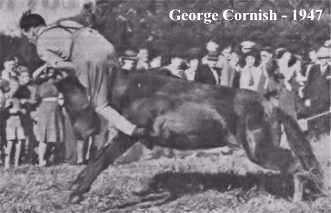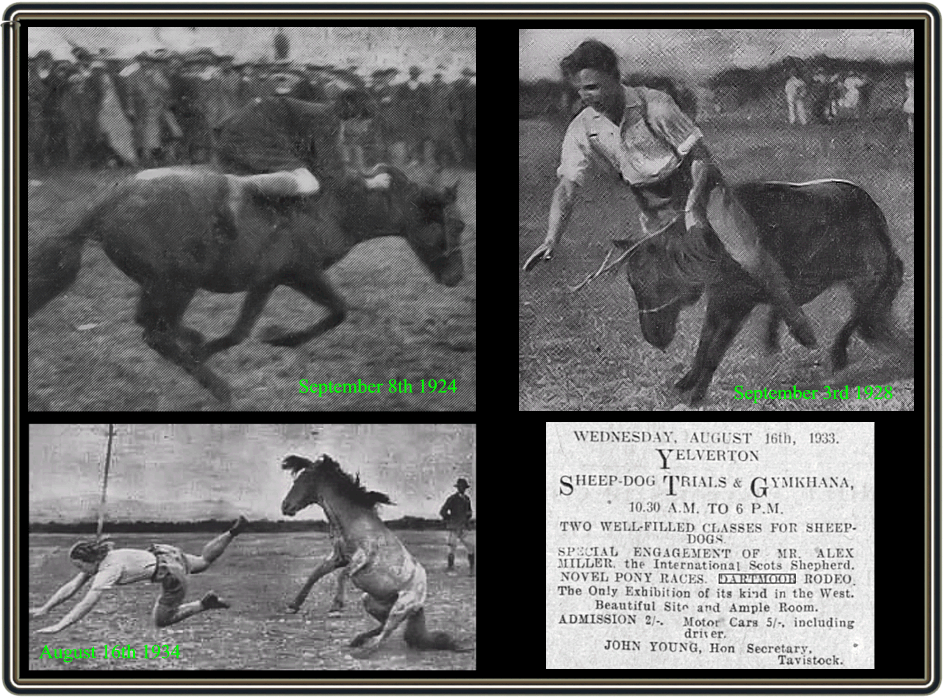
There are numerous traditions that Dartmoor can claim as being unique, this website contains many of them. But there was one that was popular in the 1920s and early 1930s that was definitely imported from elsewhere. No doubt you will have seen images of Marlboro smoking cowboys, dressed in their denims and stetsons desperately trying to remain seated on a wild bucking mustang horse or a demented bull. Well at one time such a spectacle could be seen on Dartmoor minus the all American razzmatazz with the mustangs being replaced by Dartmoor ponies and the wild bulls by moorland cattle. In 1922 the Yelverton Sheep Dog Society held their first annual sheep dog trials and gymkhana event which was staged at Heathcott Corner, Yelverton. In the 1920s and 30s one of the main attractions at the Yelverton Show was the ‘Dartmoor Rodeo’ where competitors would attempt to ride an untamed and unbroken Dartmoor pony or wild steer. The Western Morning News & Mercury reported on September the 6th 1926 that;
“Tremendous amusement was caused by the attempts which were made to ride unbroken Dartmoor Ponies without saddle or bridle, and the fact that the winner was successful in retaining his seat for only 20 seconds indicates how speedily the other 24 entrants were thrown. An even stronger objection to being ridden was shown by the untamed steers, and a 7 second record won the prize.” These tests of nerve and skill attracted entrants from all around the region with some of them coming from the local army and navy bases. As noted above the riders weren’t allowed the luxury of a bridle or saddle but did have concession of a rope halter tied around the animals neck. In 1928 the Western Morning News & Mercury described that year’s Dartmoor Rodeo; “What the crowd undoubtedly enjoyed above all else was the Dartmoor Rodeo, probably run on lines different from anywhere else in the West. Being absolutely wild, the 20 Dartmoor ponies used were typical for the sport. Some Dartmoor boy riders came from as far as Buckfastleigh and Kingsbridge on one side, and Okehampton, Lydford and Tavistock on the other. Wonderfully plucky and skillful were they in clinging to the unbroken ponies. A few girl riders put their courage and skill to the test in this event, but the prancing, buck-jumping ponies quickly gained the mastery.
The rodeo was a succession of thrills. The first success was scored by a boy, who clasping the neck of the pony with his arms could not be dislodged. Clinging to the mane of his mount, a man was swung around and around in gay fashion. He managed to regain the pony’s back, but was soon sent sprawling on the grass. A girl made a very quick return to the paddock, as did a bluejacket.
When several untamed steers were driven into the paddock for the closing event, there was a mild sensation among the crowd. Riders of the steers, which had ropes around their necks, were forth coming, but no one remained on their backs for more than an instant, except Arthur Hird of H.M.S. Dart, whose extraordinary stay was four seconds.”
For the next year or so it appeared that the wild ponies and steers were still having the upper hand and were unseating their riders in equally quick time. Luckily there seemed to be no serious reports of injuries to either the riders or their mounts. In the 1935 Dartmoor Rodeo one man, a Mr. G. Cornish managed to ride his ‘bucking bronco’ so long that it was said that he almost ‘broke’ the horse by the time it finally tipped him off. The following year Mr. G. Cornish once again took the title of the rider staying on his mount the longest, clearly he was becoming something of a ‘Rodeo Star’ as in this year he rode three different ponies.

By the early 1930s the event was being advertised as; “The Grand Dartmoor Rodeo – The riding of a wild Dartmoor pony or steer – This is the only exhibition of its sort in the West of England.” By 1936 there must have been similar events taking place elsewhere as the advert changed slightly to; “The Real Dartmoor Rodeo – as originally introduced by this society.”
I think it would be fairly safe to say that such an event would not be allowed to take place today due to animal welfare issues but at the time this did not seem a problem. Imagine those poor ponies and steers, one day you are contentedly grazing on Dartmoor and the next you have been rounded up, bundled off to Yelverton, corralled in a pen, then suddenly have a strange human being jumping of your back infront of an audience of hundreds of cheering spectators. As far as I can ascertain there was only one concern and that was the corralling of the ponies;
“The Dartmoor Rodeo at the Yelverton Gymkhana was amusing to spectators and harmless to the animals. Few of the large crowd of spectators, though, were aware of or would consciously tolerate the cruel conditions under which the twenty or more ponies received their first introduction of human treatment after their full and free life on the moor.
To my certain knowledge these poor animals were immured in a small corral for at least five and a half hours before the event. Throughout this long confinement they were without food or water, and being packed like sardines were unable to change their position or defend themselves in any way from the host of vicious horse flies which attacked them incessantly. It was indeed most distressing to witness the ponies undergoing unnecessary torture through lack of forethought. My purpose will be served if wiser and more humane arrangements are carried into effect in future events of this sort – An Animal Lover.” – The Western Morning News & Mercury, September 7th 1926.
Whether or not the local press lost interest in the event or it was discontinued but the last report I could find regarding on the Yelverton Dartmoor Rodeo was in 1938. However, in 1947 a ‘Dartmoor Rodeo’ event was staged at the Mid-Devon Hunt Gymkhana held at Chagford with the wild ponies being supplied by Messrs. Scott brothers of Chagford. On this occasion over twenty competitors competed for the title. It did not take long for other rodeos to be staged at various other events, by 1950 Lee Moor, Islington, Okehampton, Meavy, Walkhampton and South Tawton were all staging ‘rodeos’ although not advertised as ‘Dartmoor Rodeos’. Again competitors were coming from far and wide and in 1947 at the Walkhampton Gymkhana the rodeo event was won by Gunter Schwaiz, an German ex-prisoner of war. Seemingly concerns were made by various branches of the R.S.P.C.A as to the welfare of both the ponies and the steers and slowly the event died a death.
To give some idea of a rodeo Pathe News have a clip from 1964 which shows steer riding taking place just outside of Plymouth, it can be seen – HERE.
 Legendary Dartmoor The many aspects past and present of Dartmoor
Legendary Dartmoor The many aspects past and present of Dartmoor


The rodeo riding went on well into the 1950’s – and I didn’t do too bad in the Chagford show and gymkhana one in – I think – about 1957 or something. I used to ride in the gymkhanas on the Moor, plus Bovey show and all. The South Devon Hunt annual show was at Forches Cross, just outside the present National Park bounds, and was a wonderful event. It was moved to a farm nearer Newton owned by the parents of a Pony Club Prince Philip Cup Horse of the Year Show team-mate of mine called Sandra Davies. See, even 60 years on I still remember her name (and looks!). By now, rodeo riding had moved on a bit, and the money (I meand it!) was on ‘flapping’. This was pony racing, with ferocious flat-out gallops round the show circuit by rather small moor ponies driven by often much to large jockeys. Sandra, I recall, was rather good at this but I was never into horse racing – I stuck to bending (whizzing between poles), musical sacks and other such entertaining equestrian contests. They paid well: some of the wealthier Moorland agricultural shows offered as much as a pound for gymkhana event first prizes – this was 1958/59, and my starting pay as a trainee reporter on the South Devon Journal was £2 4s 2d. Hey Sands, where are you now?!
Many thanks for your interesting and informative post.
When I went for a riding holiday with Mrs Dee Ivey of Hillbridge Farm, Mary Tavy she took us to protest about the cruelty of the Dartmoor Rodeo. I think that would have been in 1966 or 67. I think that they must have finished soon after that.